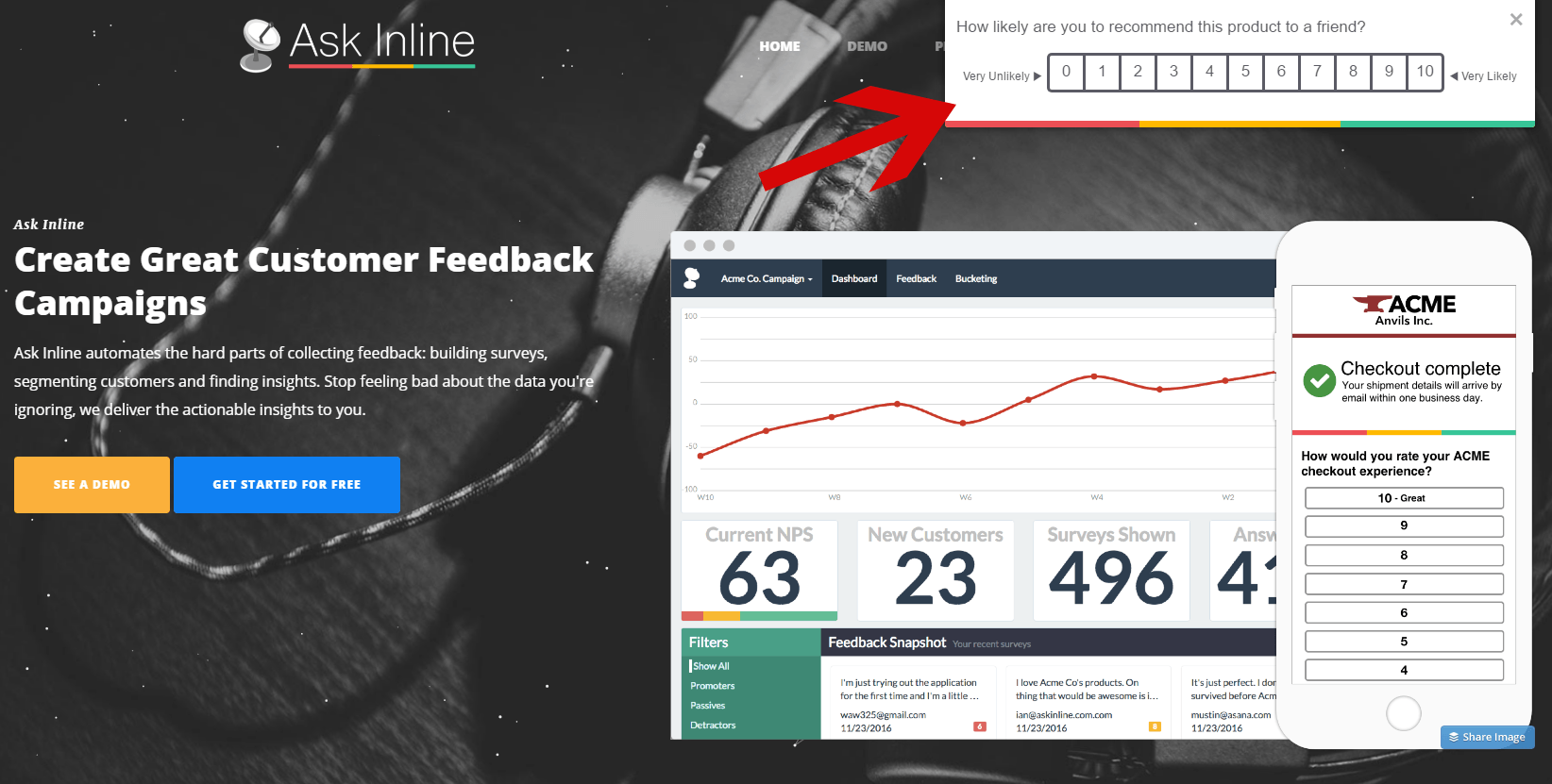Collecting Feedback at Scale from Low-Touch Customers

You know that you need feedback from your customers to improve your customer success program and your product. Customer-centricity, after all, is the best way to reduce churn.
The best way to retain customers is to create a SaaS that solves their problems and adds value to their lives. To do that, you have to 1) figure out what they value and 2) give it to them.
Low-touch SaaS organizations have a unique challenge as it’s tough to solicit feedback from users and customers when you have hundreds or thousands. There’s just no practical way to have a conversation with all of them.
In order to get the data needed to make a valuable product, you have to implement some smart automation strategies.
Feedback loops create customer-centric products
A feedback loop is a system that collects external data from customers, which is data you can’t collect yourself through analytics and adds it to your internal data (the analytics) so you can improve your product and service.
Here’s a great example of a basic feedback loop from Ott Niggulis at ConversionXL:
“If you wanted to form more strategic partnerships, you might automate a survey that goes to the customers who have been buying from you for 6 months. Why do they shop with you? What’s their lifestyle like? Where else do they shop online? Each of these questions can lead you to new partnerships and as your customer base grows, you will be provided with a continual source of new insights.”
In this example, we’re targeting customers who have been paying for six months, so we can reasonably assume they’re happy. Learning more about their wants, needs and preferences will help us reach out to other businesses to form partnerships to better serve the customers.
Feedback loops are good for customers, too. They show that you take their opinions and ideas seriously, and that you’re dedicated to building a product that provides them with the most value.
Like I said, that example is a basic feedback loop. A thoughtful feedback loop would target different segments of your customer base, your leads and even non-customers, all at different times, based on triggers.
Furthermore, your loop should be automated. In the above example, we sent one email to six-month-old customers. It would be smarter to build an automated email sequence that emails customers once they reach their six-month anniversary, and stores that data centrally.
Strategies to build automated feedback loops
You can use feedback loops to solicit information from prospects and customers at any point during the buyer’s journey. Ask website visitors why they haven’t purchased the product yet. Ask leads what’s holding them back. Ask customers what they like and don’t like about the product. Ask former customers why they canceled their service.
Here are some strategies to get those answers.
1. On-site or emailed surveys
An on-site survey is a pop-up or slide-out widget that prompts the user to answer a question. An emailed survey is a link sent directly to the user/customer’s inbox.
“Customers are often willing to give you more feedback in a private environment versus leaving an online review,” recommends Jessie Low, a customer support professional at Whitespark. “Honest feedback from current customers has huge value in helping you evaluate your business and any areas that need improvement.”
Some surveys simply collect data. They might ask Net Promoter Score questions (“Rate us from 1-10,” then “Why did you give us that rating?”) or questions about the customer’s experience.

Surveys could also ask questions with answers that direct users to more information. For example, you could have a question that says “What’s holding you back from buying [product name] today?” followed by some potential objectives. When a user selects an objection, they are taken to a page that addresses that issue.
The specific questions that you ask will depend on the purpose of your customer success program. If your goal is to reduce churn, you would ask questions like “What made you cancel your service?” or “What could we do to make you stay?”
If your goal is to improve upsell customers to higher paid plans, you might ask questions like “What else could we do to help you achieve your goals?” or “What features do you wish our product had?”
Recommended on-site survey tools: PopSurvey, Ask Inline and Qualaroo
2. Target non-customers
Just because a user didn’t convert to a customer doesn’t mean they can’t provide some information. Send a quick survey or open-ended email to people who canceled their account or never choose to buy. Ask why and what you could do better in the future.
Non-customers don’t have an incentive to answer your questions except the goodness of their own hearts, so for best results, keep this survey and email short.
3. Solicit reviews
Public reviews are excellent tools for social proof that help potential customers make purchasing decisions. While they aren’t as useful for honest feedback as surveys, they can provide some information to improve your product. Your automated feedback system should request reviews from every paying customer.
Identify your customers who have renewed at least once. Schedule an automated email to request a product review. Have replies sent to inboxes of the marketing and sales team as well.
4. On-site chat and in-app support
Unlike surveys that reach out to the customer, live chat gives customers (and free users) an option to reach out to you. These people usually have more urgent needs, so their feedback is exceptionally useful. Ez Texting used live chat to increase their signups by 31%.
Through live chat or support, user questions might tell you that your pricing page is confusing or that you prospects want to see a full list of integrations. Amazon’s Kindle with the Mayday button is an excellent example of how live support can collect feedback and make customers feel comfortable.

Recommended live chat tools: ClickDesk, Drift, and Olark.
5. Social listening
People are brutally honest on social media, making it a fantastic place to discover feedback. You can directly ask your fans and followers how they feel about certain topics. You can also use a tool like Mention to find anyone who is having a conversation about your product/brand/company online.
6. Your data/analytics
Sometimes the best way to gather feedback from your customer is to observe their behavior without their awareness. Sure, on some level they know you can see how they use the product, but that usually doesn’t affect their behavior.
Use your analytics to turn raw data into insights. If users are avoiding a particular feature, fail to complete a particular workflow, or favor one element/button/link/image/dashboard/metric/whatever over another, ask yourself (or them) why.
Customer check-ins usually aren’t worth your time, but maybe…
Customers of high-touch products and enterprise products have the luxury of getting their customers on the phone. In many cases, high-touch customers expect to have the direct number to a customer success manager, and CSMs routinely initiate contact. It’s a much closer relationship.
If you call a customer, have something valuable to say first, like new information to share or action items for your quarterly business review.
Calling low-touch customers is problematic, because you usually have a lot more of them. Their needs are smaller, so it’s likely you’ll just interrupt their day.
However, there’s always value in talking to a customer. “When we’re using surveys, email, or analytics, we’re missing all sorts of contextual information,” says Lars Lofgren, marketing analyst at Kissmetrics.
Obviously, you can’t call all of your low-touch customers. There isn’t enough time in the day. So, you have to pick the ones that will provide you the most value. Here is some criteria to help you identify those customers:
- Customers who pay significantly more for your product that other accounts
- Customers who use your product significantly more (in terms of time and user accounts)
- Customers who access more resources (content, knowledgebase, other tools, etc.)
- Customers who have used customer support most often
Basically, you could reach out to any customer who interacts with your business in some meaningful way more than other customers. Your criteria will vary.
Just like high-touch products, you should always give them something in exchange for their time. That might mean a specialty piece of content, a unique marketing opportunity, a collaborative partnership, or, simply, a discount on next month’s service.
The most important step
Feedback is useless unless you use it. Turn the data that you collect into insights that have actionable value. Use your information to improve your customer success program and distribute your findings to other teams within your organization so they can improve their work. This is the only way to produce a customer-centric product that retains customers.
